Marketing Strategies and Consumer Markets in Hospitality Industry
VerifiedAdded on 2023/02/10
|16
|3678
|67
Report
AI Summary
This report provides a comprehensive overview of marketing principles within the hospitality industry. It begins by defining marketing concepts and their application, using Hilton Hotels as a case study to illustrate societal marketing. The report then analyzes the impact of the marketing environment, including SWOT and PEST analyses, on hospitality businesses. It explores the relevance of consumer markets, including the black box model, and the rationale for market segmentation. Furthermore, the report delves into the importance of the marketing mix (product, price, place, promotion), examining pricing strategies employed by Thomas Cook Travel. Finally, it evaluates the role of the promotional mix, including advertising, sales promotion, personal selling, public relations, and sponsorship, with a focus on the effectiveness of sales promotion and public relations in driving business success. This report is a valuable resource for understanding and applying marketing strategies in the hospitality sector.
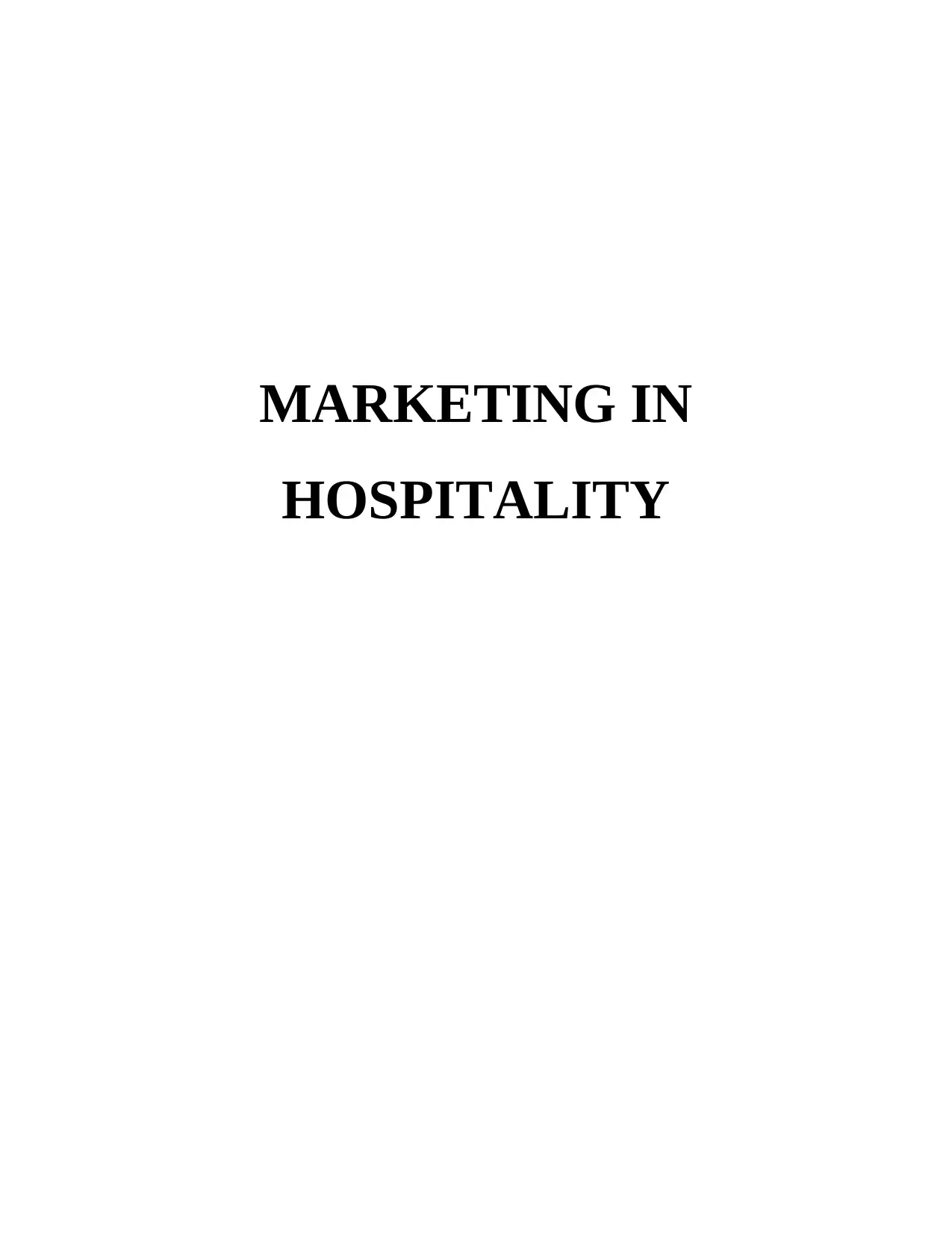
MARKETING IN
HOSPITALITY
HOSPITALITY
Paraphrase This Document
Need a fresh take? Get an instant paraphrase of this document with our AI Paraphraser
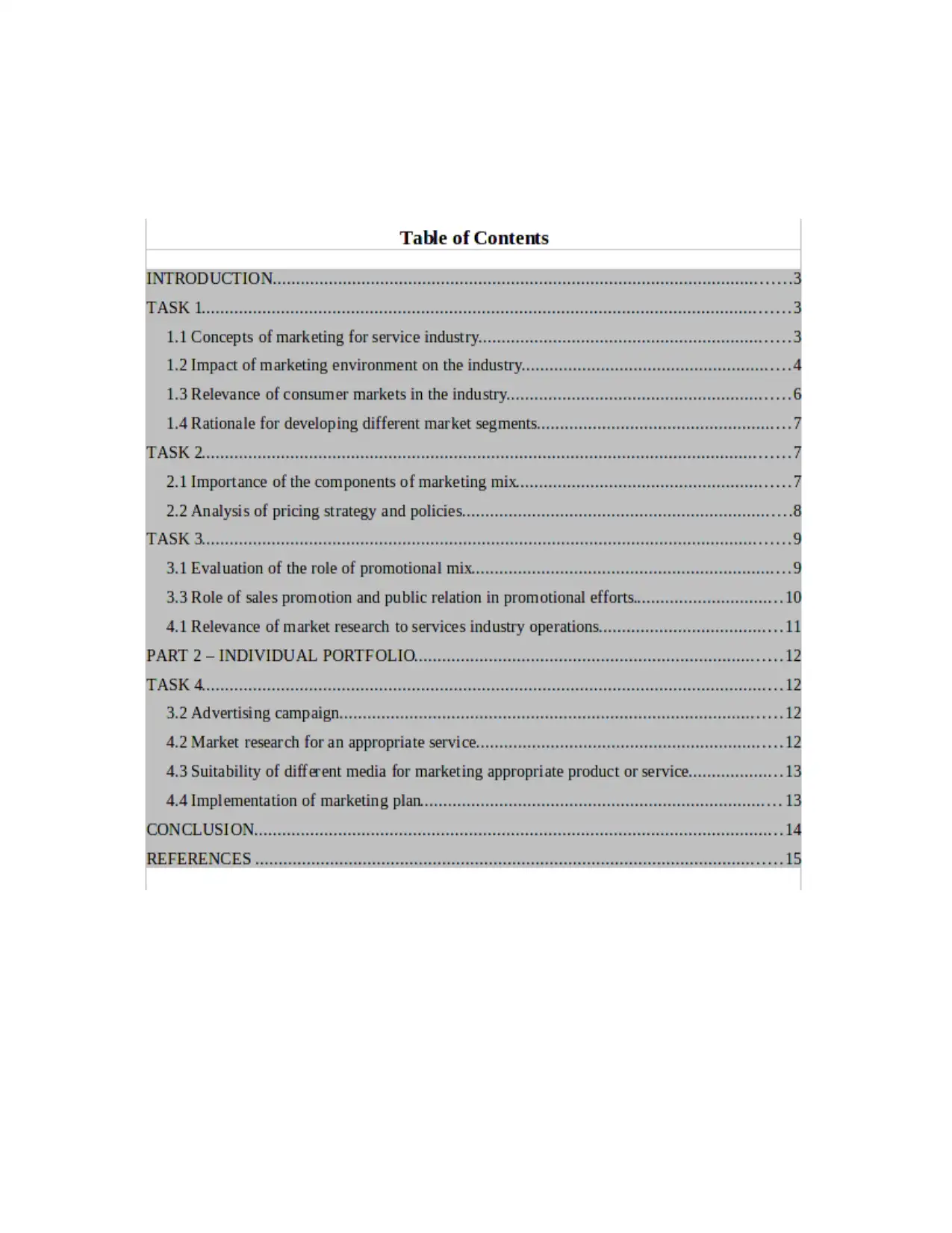

INTRODUCTION
Hospitality marketing is referred to the efforts made by marketing department in order to
increase the revenues of any hospitality industry. Marketing is a process which facilitates
company to distribute its product or services to its customers from manufacturer and in the case
of hospitality marketing looks at how segments of the hospitality industry, such as hotels,
restaurants, resorts, etc. utilize its marketing techniques to promote their products and services
(Tresidder, 2015). Hospitality industry develop their marketing plan in effective manner by using
different marketing functions and marketing mix. This assignment will focus on concepts of
marketing, impact of marketing environment on industry. It also includes relevance of consumer
markets in hospitality industry. It also explains the case study given in the assignment. In
addition to this, individual portfolio is also given in this assignment.
TASK 1
1.1 Concepts of marketing for service industry
As mentioned above, marketing is defined as a process or action through which company
sell or distribute its products to the target market or consumer from manufacturer. Hilton hotel is
one of the reputed hotels in the hospitality industry. They are known for their customer services
and dedicated staff members all round the world. Main aim of Hilton is to provide best services
to its customers in a way that people can see the difference of their services compared to other
hotel. They market in such a manner that the services and hospitality are different and better as
compared to others (Bowie and et al, 2016). They have strong marketing department and all
people associated are fully dedicated to their responsibilities. They know that customer care is
very important and is the key for any hospital industry, so Hilton develop marketing plans in
order to ensure customer satisfaction. They follow societal marketing concept and is explained
below:
Societal marketing concept: In this, the company develop their market plan in order to
serve their customers by fulfilling their needs, desires and interests. Hilton Hotels are known for
their outstanding services and they ensures that they maintain their services in order to remain
ahead of other competitors.
Hospitality marketing is referred to the efforts made by marketing department in order to
increase the revenues of any hospitality industry. Marketing is a process which facilitates
company to distribute its product or services to its customers from manufacturer and in the case
of hospitality marketing looks at how segments of the hospitality industry, such as hotels,
restaurants, resorts, etc. utilize its marketing techniques to promote their products and services
(Tresidder, 2015). Hospitality industry develop their marketing plan in effective manner by using
different marketing functions and marketing mix. This assignment will focus on concepts of
marketing, impact of marketing environment on industry. It also includes relevance of consumer
markets in hospitality industry. It also explains the case study given in the assignment. In
addition to this, individual portfolio is also given in this assignment.
TASK 1
1.1 Concepts of marketing for service industry
As mentioned above, marketing is defined as a process or action through which company
sell or distribute its products to the target market or consumer from manufacturer. Hilton hotel is
one of the reputed hotels in the hospitality industry. They are known for their customer services
and dedicated staff members all round the world. Main aim of Hilton is to provide best services
to its customers in a way that people can see the difference of their services compared to other
hotel. They market in such a manner that the services and hospitality are different and better as
compared to others (Bowie and et al, 2016). They have strong marketing department and all
people associated are fully dedicated to their responsibilities. They know that customer care is
very important and is the key for any hospital industry, so Hilton develop marketing plans in
order to ensure customer satisfaction. They follow societal marketing concept and is explained
below:
Societal marketing concept: In this, the company develop their market plan in order to
serve their customers by fulfilling their needs, desires and interests. Hilton Hotels are known for
their outstanding services and they ensures that they maintain their services in order to remain
ahead of other competitors.
⊘ This is a preview!⊘
Do you want full access?
Subscribe today to unlock all pages.

Trusted by 1+ million students worldwide
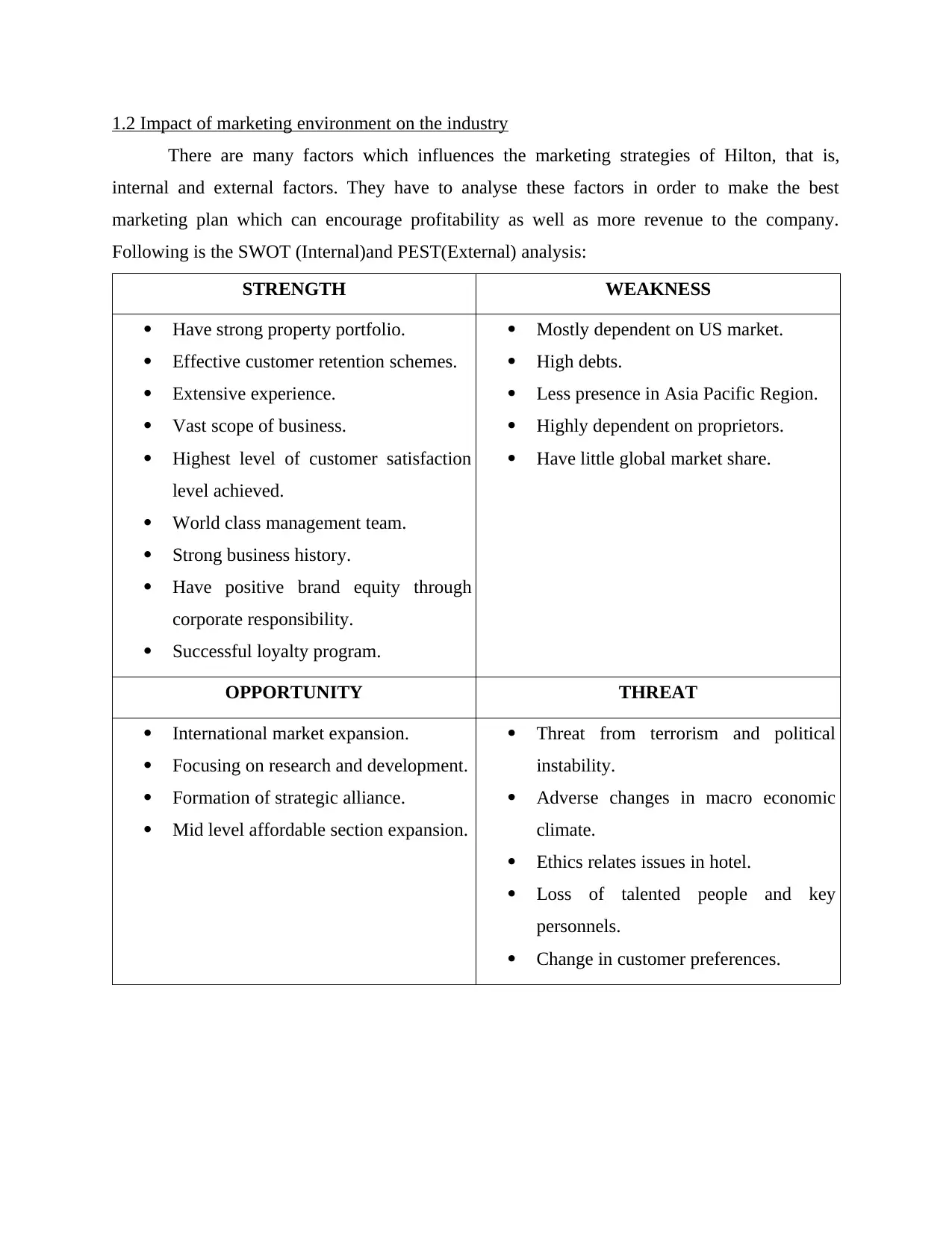
1.2 Impact of marketing environment on the industry
There are many factors which influences the marketing strategies of Hilton, that is,
internal and external factors. They have to analyse these factors in order to make the best
marketing plan which can encourage profitability as well as more revenue to the company.
Following is the SWOT (Internal)and PEST(External) analysis:
STRENGTH WEAKNESS
Have strong property portfolio.
Effective customer retention schemes.
Extensive experience.
Vast scope of business.
Highest level of customer satisfaction
level achieved.
World class management team.
Strong business history.
Have positive brand equity through
corporate responsibility.
Successful loyalty program.
Mostly dependent on US market.
High debts.
Less presence in Asia Pacific Region.
Highly dependent on proprietors.
Have little global market share.
OPPORTUNITY THREAT
International market expansion.
Focusing on research and development.
Formation of strategic alliance.
Mid level affordable section expansion.
Threat from terrorism and political
instability.
Adverse changes in macro economic
climate.
Ethics relates issues in hotel.
Loss of talented people and key
personnels.
Change in customer preferences.
There are many factors which influences the marketing strategies of Hilton, that is,
internal and external factors. They have to analyse these factors in order to make the best
marketing plan which can encourage profitability as well as more revenue to the company.
Following is the SWOT (Internal)and PEST(External) analysis:
STRENGTH WEAKNESS
Have strong property portfolio.
Effective customer retention schemes.
Extensive experience.
Vast scope of business.
Highest level of customer satisfaction
level achieved.
World class management team.
Strong business history.
Have positive brand equity through
corporate responsibility.
Successful loyalty program.
Mostly dependent on US market.
High debts.
Less presence in Asia Pacific Region.
Highly dependent on proprietors.
Have little global market share.
OPPORTUNITY THREAT
International market expansion.
Focusing on research and development.
Formation of strategic alliance.
Mid level affordable section expansion.
Threat from terrorism and political
instability.
Adverse changes in macro economic
climate.
Ethics relates issues in hotel.
Loss of talented people and key
personnels.
Change in customer preferences.
Paraphrase This Document
Need a fresh take? Get an instant paraphrase of this document with our AI Paraphraser
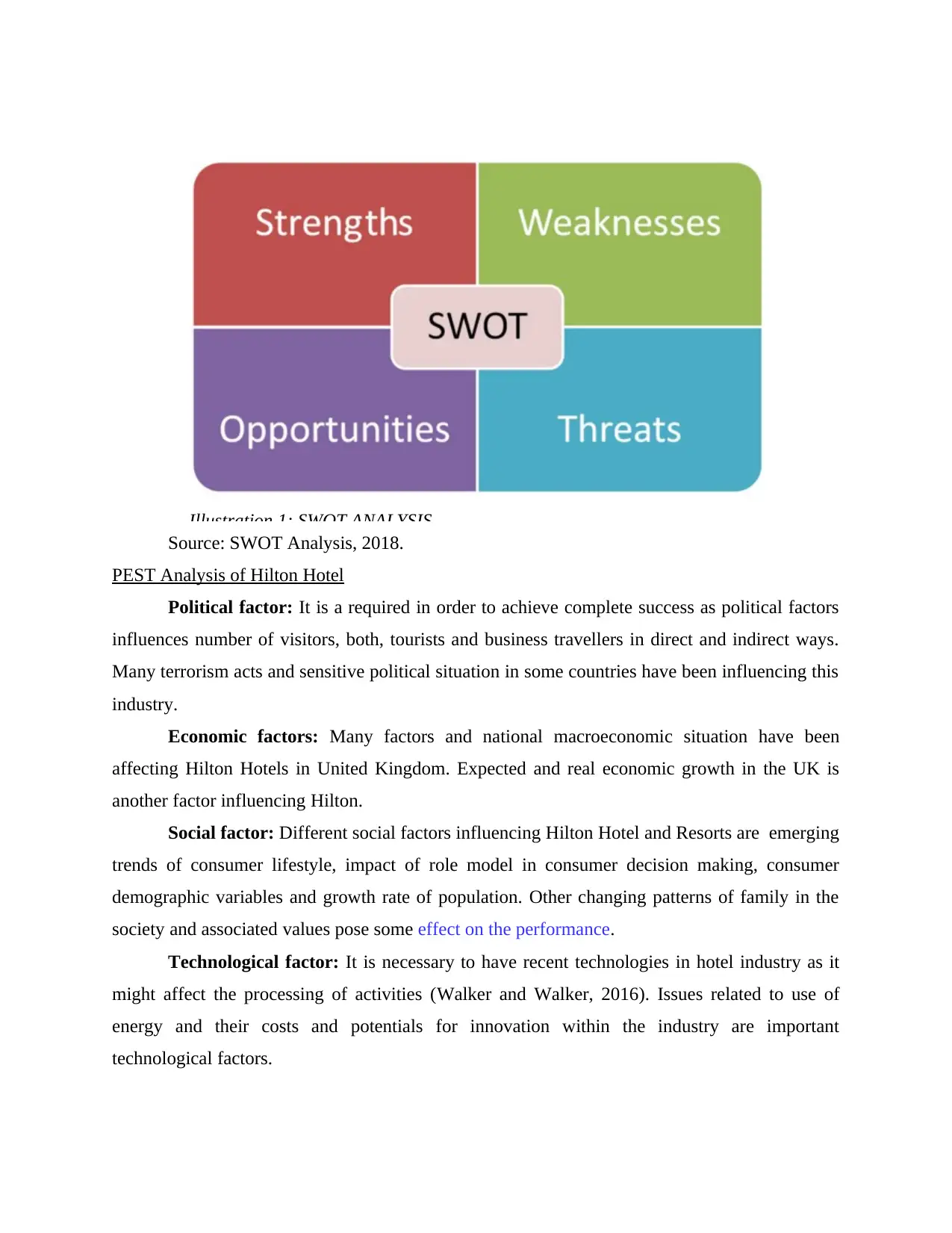
Source: SWOT Analysis, 2018.
PEST Analysis of Hilton Hotel
Political factor: It is a required in order to achieve complete success as political factors
influences number of visitors, both, tourists and business travellers in direct and indirect ways.
Many terrorism acts and sensitive political situation in some countries have been influencing this
industry.
Economic factors: Many factors and national macroeconomic situation have been
affecting Hilton Hotels in United Kingdom. Expected and real economic growth in the UK is
another factor influencing Hilton.
Social factor: Different social factors influencing Hilton Hotel and Resorts are emerging
trends of consumer lifestyle, impact of role model in consumer decision making, consumer
demographic variables and growth rate of population. Other changing patterns of family in the
society and associated values pose some effect on the performance.
Technological factor: It is necessary to have recent technologies in hotel industry as it
might affect the processing of activities (Walker and Walker, 2016). Issues related to use of
energy and their costs and potentials for innovation within the industry are important
technological factors.
Illustration 1: SWOT ANALYSIS
PEST Analysis of Hilton Hotel
Political factor: It is a required in order to achieve complete success as political factors
influences number of visitors, both, tourists and business travellers in direct and indirect ways.
Many terrorism acts and sensitive political situation in some countries have been influencing this
industry.
Economic factors: Many factors and national macroeconomic situation have been
affecting Hilton Hotels in United Kingdom. Expected and real economic growth in the UK is
another factor influencing Hilton.
Social factor: Different social factors influencing Hilton Hotel and Resorts are emerging
trends of consumer lifestyle, impact of role model in consumer decision making, consumer
demographic variables and growth rate of population. Other changing patterns of family in the
society and associated values pose some effect on the performance.
Technological factor: It is necessary to have recent technologies in hotel industry as it
might affect the processing of activities (Walker and Walker, 2016). Issues related to use of
energy and their costs and potentials for innovation within the industry are important
technological factors.
Illustration 1: SWOT ANALYSIS
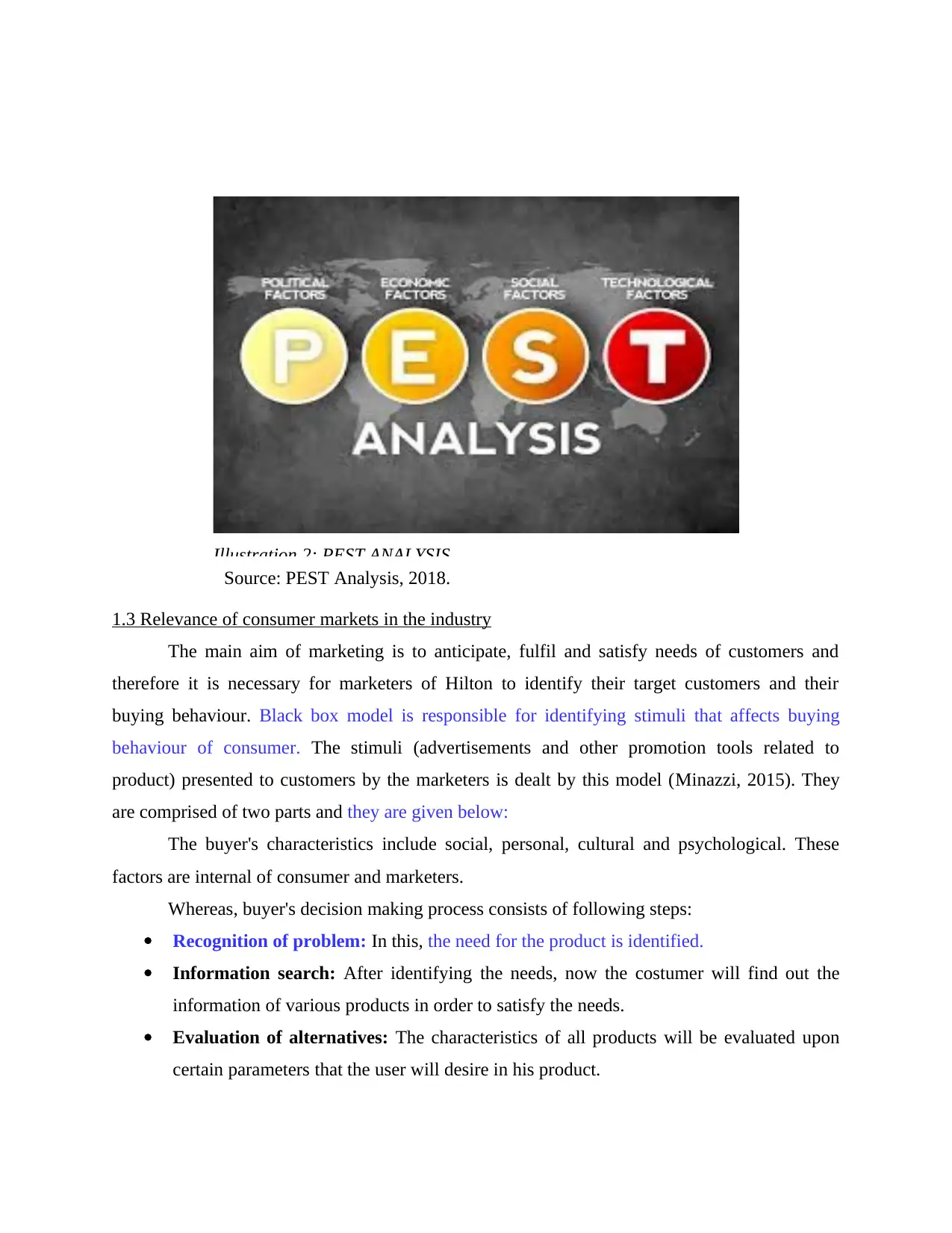
Source: PEST Analysis, 2018.
1.3 Relevance of consumer markets in the industry
The main aim of marketing is to anticipate, fulfil and satisfy needs of customers and
therefore it is necessary for marketers of Hilton to identify their target customers and their
buying behaviour. Black box model is responsible for identifying stimuli that affects buying
behaviour of consumer. The stimuli (advertisements and other promotion tools related to
product) presented to customers by the marketers is dealt by this model (Minazzi, 2015). They
are comprised of two parts and they are given below:
The buyer's characteristics include social, personal, cultural and psychological. These
factors are internal of consumer and marketers.
Whereas, buyer's decision making process consists of following steps:
Recognition of problem: In this, the need for the product is identified.
Information search: After identifying the needs, now the costumer will find out the
information of various products in order to satisfy the needs.
Evaluation of alternatives: The characteristics of all products will be evaluated upon
certain parameters that the user will desire in his product.
Illustration 2: PEST ANALYSIS
1.3 Relevance of consumer markets in the industry
The main aim of marketing is to anticipate, fulfil and satisfy needs of customers and
therefore it is necessary for marketers of Hilton to identify their target customers and their
buying behaviour. Black box model is responsible for identifying stimuli that affects buying
behaviour of consumer. The stimuli (advertisements and other promotion tools related to
product) presented to customers by the marketers is dealt by this model (Minazzi, 2015). They
are comprised of two parts and they are given below:
The buyer's characteristics include social, personal, cultural and psychological. These
factors are internal of consumer and marketers.
Whereas, buyer's decision making process consists of following steps:
Recognition of problem: In this, the need for the product is identified.
Information search: After identifying the needs, now the costumer will find out the
information of various products in order to satisfy the needs.
Evaluation of alternatives: The characteristics of all products will be evaluated upon
certain parameters that the user will desire in his product.
Illustration 2: PEST ANALYSIS
⊘ This is a preview!⊘
Do you want full access?
Subscribe today to unlock all pages.

Trusted by 1+ million students worldwide
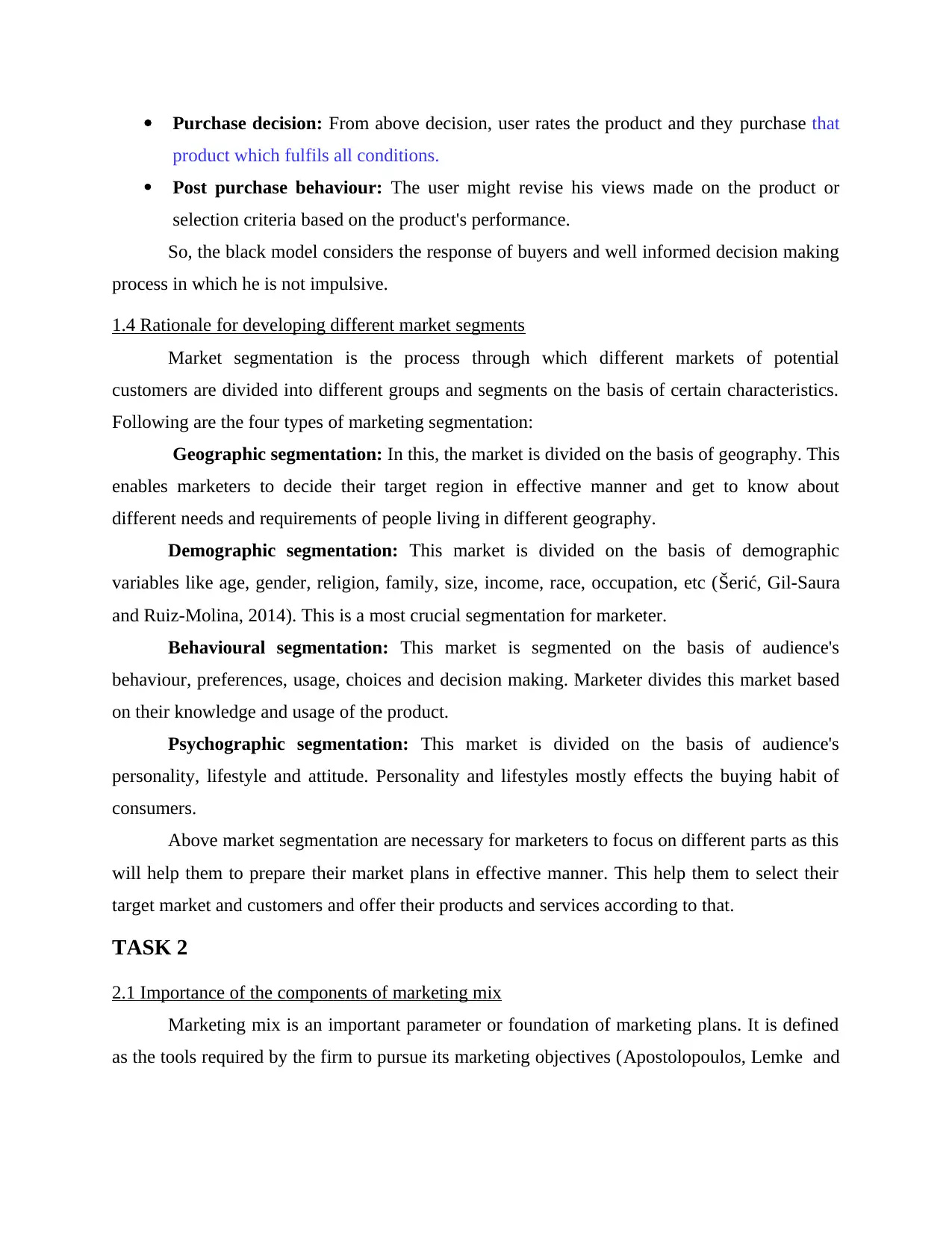
Purchase decision: From above decision, user rates the product and they purchase that
product which fulfils all conditions.
Post purchase behaviour: The user might revise his views made on the product or
selection criteria based on the product's performance.
So, the black model considers the response of buyers and well informed decision making
process in which he is not impulsive.
1.4 Rationale for developing different market segments
Market segmentation is the process through which different markets of potential
customers are divided into different groups and segments on the basis of certain characteristics.
Following are the four types of marketing segmentation:
Geographic segmentation: In this, the market is divided on the basis of geography. This
enables marketers to decide their target region in effective manner and get to know about
different needs and requirements of people living in different geography.
Demographic segmentation: This market is divided on the basis of demographic
variables like age, gender, religion, family, size, income, race, occupation, etc (Šerić, Gil-Saura
and Ruiz-Molina, 2014). This is a most crucial segmentation for marketer.
Behavioural segmentation: This market is segmented on the basis of audience's
behaviour, preferences, usage, choices and decision making. Marketer divides this market based
on their knowledge and usage of the product.
Psychographic segmentation: This market is divided on the basis of audience's
personality, lifestyle and attitude. Personality and lifestyles mostly effects the buying habit of
consumers.
Above market segmentation are necessary for marketers to focus on different parts as this
will help them to prepare their market plans in effective manner. This help them to select their
target market and customers and offer their products and services according to that.
TASK 2
2.1 Importance of the components of marketing mix
Marketing mix is an important parameter or foundation of marketing plans. It is defined
as the tools required by the firm to pursue its marketing objectives (Apostolopoulos, Lemke and
product which fulfils all conditions.
Post purchase behaviour: The user might revise his views made on the product or
selection criteria based on the product's performance.
So, the black model considers the response of buyers and well informed decision making
process in which he is not impulsive.
1.4 Rationale for developing different market segments
Market segmentation is the process through which different markets of potential
customers are divided into different groups and segments on the basis of certain characteristics.
Following are the four types of marketing segmentation:
Geographic segmentation: In this, the market is divided on the basis of geography. This
enables marketers to decide their target region in effective manner and get to know about
different needs and requirements of people living in different geography.
Demographic segmentation: This market is divided on the basis of demographic
variables like age, gender, religion, family, size, income, race, occupation, etc (Šerić, Gil-Saura
and Ruiz-Molina, 2014). This is a most crucial segmentation for marketer.
Behavioural segmentation: This market is segmented on the basis of audience's
behaviour, preferences, usage, choices and decision making. Marketer divides this market based
on their knowledge and usage of the product.
Psychographic segmentation: This market is divided on the basis of audience's
personality, lifestyle and attitude. Personality and lifestyles mostly effects the buying habit of
consumers.
Above market segmentation are necessary for marketers to focus on different parts as this
will help them to prepare their market plans in effective manner. This help them to select their
target market and customers and offer their products and services according to that.
TASK 2
2.1 Importance of the components of marketing mix
Marketing mix is an important parameter or foundation of marketing plans. It is defined
as the tools required by the firm to pursue its marketing objectives (Apostolopoulos, Lemke and
Paraphrase This Document
Need a fresh take? Get an instant paraphrase of this document with our AI Paraphraser
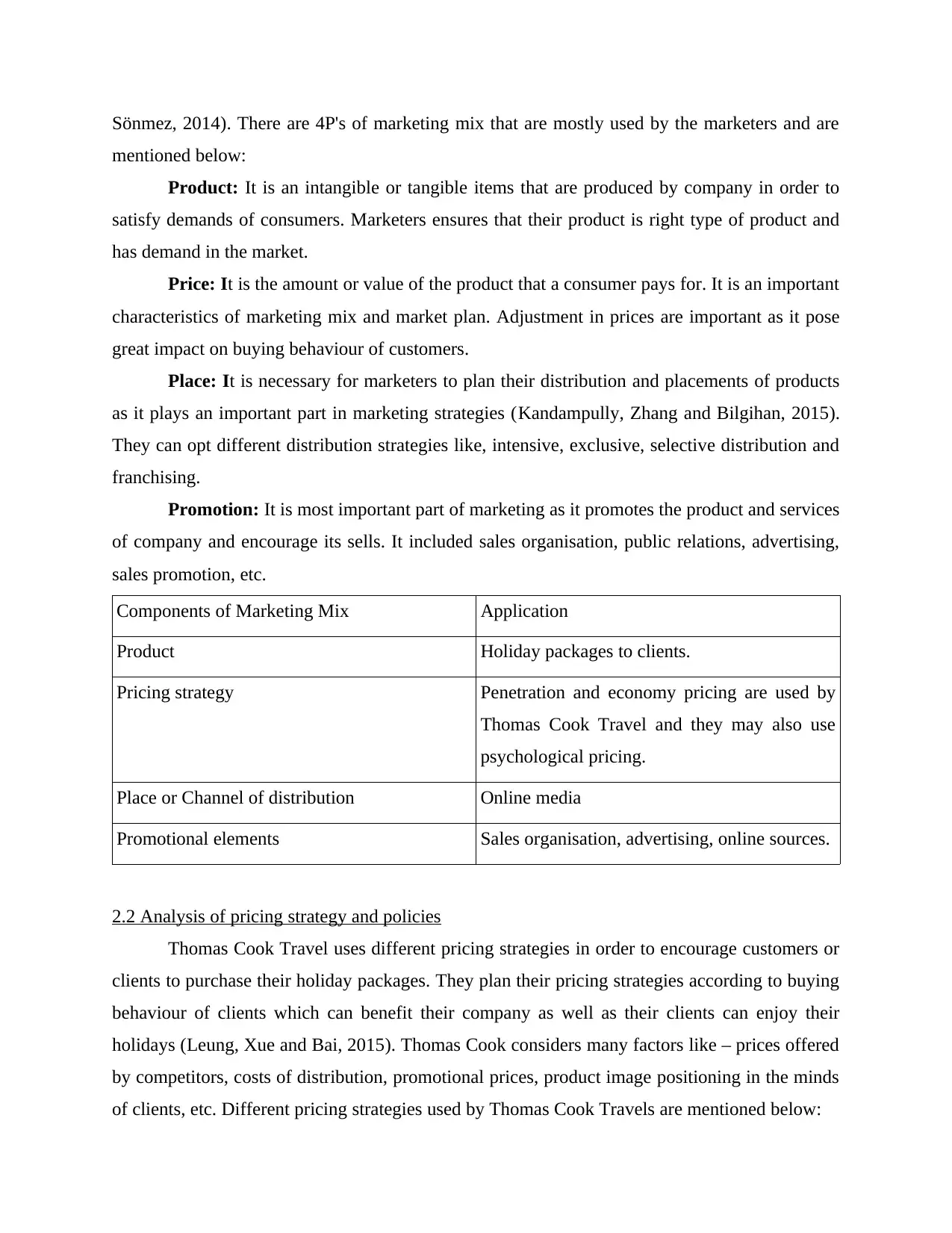
Sönmez, 2014). There are 4P's of marketing mix that are mostly used by the marketers and are
mentioned below:
Product: It is an intangible or tangible items that are produced by company in order to
satisfy demands of consumers. Marketers ensures that their product is right type of product and
has demand in the market.
Price: It is the amount or value of the product that a consumer pays for. It is an important
characteristics of marketing mix and market plan. Adjustment in prices are important as it pose
great impact on buying behaviour of customers.
Place: It is necessary for marketers to plan their distribution and placements of products
as it plays an important part in marketing strategies (Kandampully, Zhang and Bilgihan, 2015).
They can opt different distribution strategies like, intensive, exclusive, selective distribution and
franchising.
Promotion: It is most important part of marketing as it promotes the product and services
of company and encourage its sells. It included sales organisation, public relations, advertising,
sales promotion, etc.
Components of Marketing Mix Application
Product Holiday packages to clients.
Pricing strategy Penetration and economy pricing are used by
Thomas Cook Travel and they may also use
psychological pricing.
Place or Channel of distribution Online media
Promotional elements Sales organisation, advertising, online sources.
2.2 Analysis of pricing strategy and policies
Thomas Cook Travel uses different pricing strategies in order to encourage customers or
clients to purchase their holiday packages. They plan their pricing strategies according to buying
behaviour of clients which can benefit their company as well as their clients can enjoy their
holidays (Leung, Xue and Bai, 2015). Thomas Cook considers many factors like – prices offered
by competitors, costs of distribution, promotional prices, product image positioning in the minds
of clients, etc. Different pricing strategies used by Thomas Cook Travels are mentioned below:
mentioned below:
Product: It is an intangible or tangible items that are produced by company in order to
satisfy demands of consumers. Marketers ensures that their product is right type of product and
has demand in the market.
Price: It is the amount or value of the product that a consumer pays for. It is an important
characteristics of marketing mix and market plan. Adjustment in prices are important as it pose
great impact on buying behaviour of customers.
Place: It is necessary for marketers to plan their distribution and placements of products
as it plays an important part in marketing strategies (Kandampully, Zhang and Bilgihan, 2015).
They can opt different distribution strategies like, intensive, exclusive, selective distribution and
franchising.
Promotion: It is most important part of marketing as it promotes the product and services
of company and encourage its sells. It included sales organisation, public relations, advertising,
sales promotion, etc.
Components of Marketing Mix Application
Product Holiday packages to clients.
Pricing strategy Penetration and economy pricing are used by
Thomas Cook Travel and they may also use
psychological pricing.
Place or Channel of distribution Online media
Promotional elements Sales organisation, advertising, online sources.
2.2 Analysis of pricing strategy and policies
Thomas Cook Travel uses different pricing strategies in order to encourage customers or
clients to purchase their holiday packages. They plan their pricing strategies according to buying
behaviour of clients which can benefit their company as well as their clients can enjoy their
holidays (Leung, Xue and Bai, 2015). Thomas Cook considers many factors like – prices offered
by competitors, costs of distribution, promotional prices, product image positioning in the minds
of clients, etc. Different pricing strategies used by Thomas Cook Travels are mentioned below:
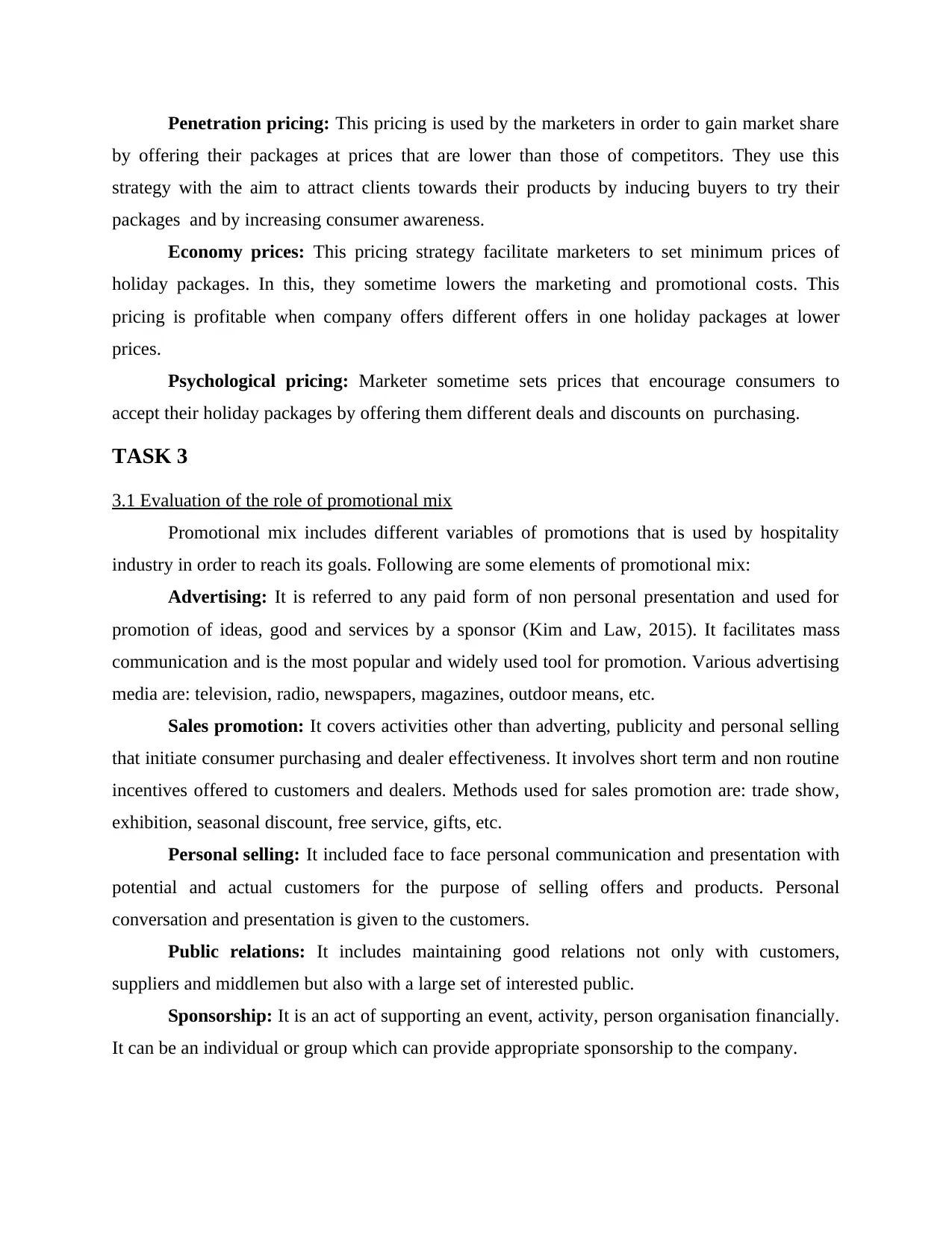
Penetration pricing: This pricing is used by the marketers in order to gain market share
by offering their packages at prices that are lower than those of competitors. They use this
strategy with the aim to attract clients towards their products by inducing buyers to try their
packages and by increasing consumer awareness.
Economy prices: This pricing strategy facilitate marketers to set minimum prices of
holiday packages. In this, they sometime lowers the marketing and promotional costs. This
pricing is profitable when company offers different offers in one holiday packages at lower
prices.
Psychological pricing: Marketer sometime sets prices that encourage consumers to
accept their holiday packages by offering them different deals and discounts on purchasing.
TASK 3
3.1 Evaluation of the role of promotional mix
Promotional mix includes different variables of promotions that is used by hospitality
industry in order to reach its goals. Following are some elements of promotional mix:
Advertising: It is referred to any paid form of non personal presentation and used for
promotion of ideas, good and services by a sponsor (Kim and Law, 2015). It facilitates mass
communication and is the most popular and widely used tool for promotion. Various advertising
media are: television, radio, newspapers, magazines, outdoor means, etc.
Sales promotion: It covers activities other than adverting, publicity and personal selling
that initiate consumer purchasing and dealer effectiveness. It involves short term and non routine
incentives offered to customers and dealers. Methods used for sales promotion are: trade show,
exhibition, seasonal discount, free service, gifts, etc.
Personal selling: It included face to face personal communication and presentation with
potential and actual customers for the purpose of selling offers and products. Personal
conversation and presentation is given to the customers.
Public relations: It includes maintaining good relations not only with customers,
suppliers and middlemen but also with a large set of interested public.
Sponsorship: It is an act of supporting an event, activity, person organisation financially.
It can be an individual or group which can provide appropriate sponsorship to the company.
by offering their packages at prices that are lower than those of competitors. They use this
strategy with the aim to attract clients towards their products by inducing buyers to try their
packages and by increasing consumer awareness.
Economy prices: This pricing strategy facilitate marketers to set minimum prices of
holiday packages. In this, they sometime lowers the marketing and promotional costs. This
pricing is profitable when company offers different offers in one holiday packages at lower
prices.
Psychological pricing: Marketer sometime sets prices that encourage consumers to
accept their holiday packages by offering them different deals and discounts on purchasing.
TASK 3
3.1 Evaluation of the role of promotional mix
Promotional mix includes different variables of promotions that is used by hospitality
industry in order to reach its goals. Following are some elements of promotional mix:
Advertising: It is referred to any paid form of non personal presentation and used for
promotion of ideas, good and services by a sponsor (Kim and Law, 2015). It facilitates mass
communication and is the most popular and widely used tool for promotion. Various advertising
media are: television, radio, newspapers, magazines, outdoor means, etc.
Sales promotion: It covers activities other than adverting, publicity and personal selling
that initiate consumer purchasing and dealer effectiveness. It involves short term and non routine
incentives offered to customers and dealers. Methods used for sales promotion are: trade show,
exhibition, seasonal discount, free service, gifts, etc.
Personal selling: It included face to face personal communication and presentation with
potential and actual customers for the purpose of selling offers and products. Personal
conversation and presentation is given to the customers.
Public relations: It includes maintaining good relations not only with customers,
suppliers and middlemen but also with a large set of interested public.
Sponsorship: It is an act of supporting an event, activity, person organisation financially.
It can be an individual or group which can provide appropriate sponsorship to the company.
⊘ This is a preview!⊘
Do you want full access?
Subscribe today to unlock all pages.

Trusted by 1+ million students worldwide
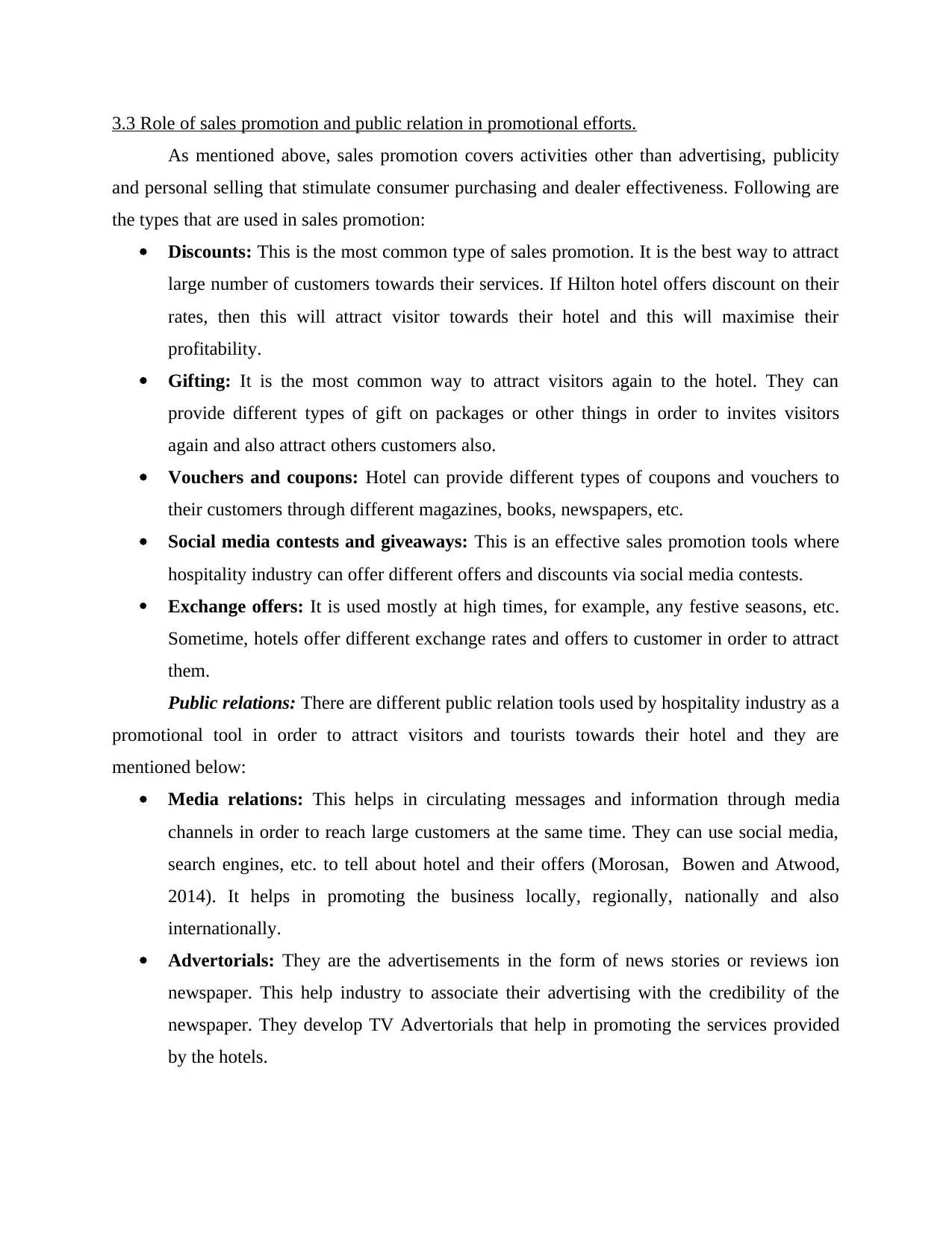
3.3 Role of sales promotion and public relation in promotional efforts.
As mentioned above, sales promotion covers activities other than advertising, publicity
and personal selling that stimulate consumer purchasing and dealer effectiveness. Following are
the types that are used in sales promotion:
Discounts: This is the most common type of sales promotion. It is the best way to attract
large number of customers towards their services. If Hilton hotel offers discount on their
rates, then this will attract visitor towards their hotel and this will maximise their
profitability.
Gifting: It is the most common way to attract visitors again to the hotel. They can
provide different types of gift on packages or other things in order to invites visitors
again and also attract others customers also.
Vouchers and coupons: Hotel can provide different types of coupons and vouchers to
their customers through different magazines, books, newspapers, etc.
Social media contests and giveaways: This is an effective sales promotion tools where
hospitality industry can offer different offers and discounts via social media contests.
Exchange offers: It is used mostly at high times, for example, any festive seasons, etc.
Sometime, hotels offer different exchange rates and offers to customer in order to attract
them.
Public relations: There are different public relation tools used by hospitality industry as a
promotional tool in order to attract visitors and tourists towards their hotel and they are
mentioned below:
Media relations: This helps in circulating messages and information through media
channels in order to reach large customers at the same time. They can use social media,
search engines, etc. to tell about hotel and their offers (Morosan, Bowen and Atwood,
2014). It helps in promoting the business locally, regionally, nationally and also
internationally.
Advertorials: They are the advertisements in the form of news stories or reviews ion
newspaper. This help industry to associate their advertising with the credibility of the
newspaper. They develop TV Advertorials that help in promoting the services provided
by the hotels.
As mentioned above, sales promotion covers activities other than advertising, publicity
and personal selling that stimulate consumer purchasing and dealer effectiveness. Following are
the types that are used in sales promotion:
Discounts: This is the most common type of sales promotion. It is the best way to attract
large number of customers towards their services. If Hilton hotel offers discount on their
rates, then this will attract visitor towards their hotel and this will maximise their
profitability.
Gifting: It is the most common way to attract visitors again to the hotel. They can
provide different types of gift on packages or other things in order to invites visitors
again and also attract others customers also.
Vouchers and coupons: Hotel can provide different types of coupons and vouchers to
their customers through different magazines, books, newspapers, etc.
Social media contests and giveaways: This is an effective sales promotion tools where
hospitality industry can offer different offers and discounts via social media contests.
Exchange offers: It is used mostly at high times, for example, any festive seasons, etc.
Sometime, hotels offer different exchange rates and offers to customer in order to attract
them.
Public relations: There are different public relation tools used by hospitality industry as a
promotional tool in order to attract visitors and tourists towards their hotel and they are
mentioned below:
Media relations: This helps in circulating messages and information through media
channels in order to reach large customers at the same time. They can use social media,
search engines, etc. to tell about hotel and their offers (Morosan, Bowen and Atwood,
2014). It helps in promoting the business locally, regionally, nationally and also
internationally.
Advertorials: They are the advertisements in the form of news stories or reviews ion
newspaper. This help industry to associate their advertising with the credibility of the
newspaper. They develop TV Advertorials that help in promoting the services provided
by the hotels.
Paraphrase This Document
Need a fresh take? Get an instant paraphrase of this document with our AI Paraphraser
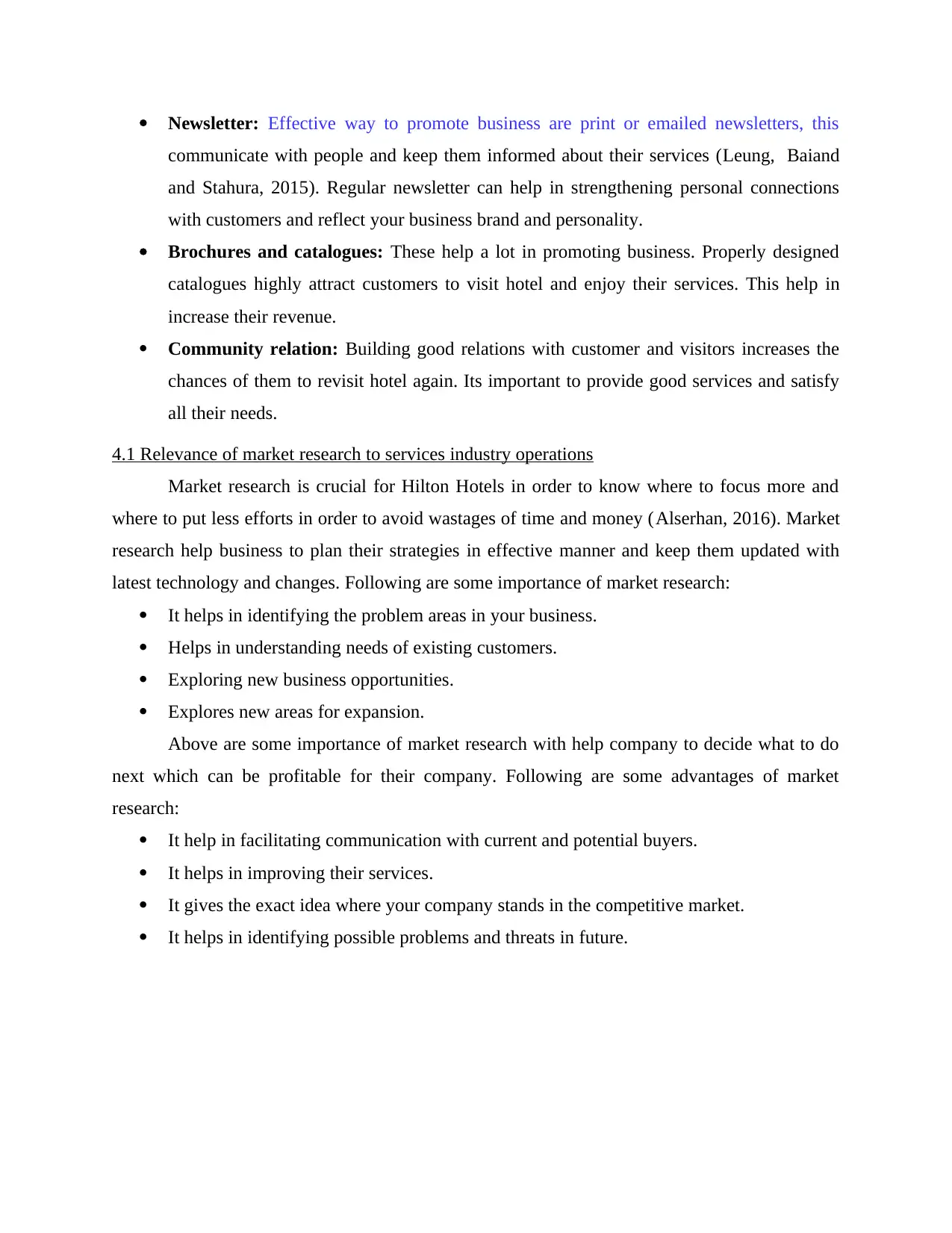
Newsletter: Effective way to promote business are print or emailed newsletters, this
communicate with people and keep them informed about their services (Leung, Baiand
and Stahura, 2015). Regular newsletter can help in strengthening personal connections
with customers and reflect your business brand and personality.
Brochures and catalogues: These help a lot in promoting business. Properly designed
catalogues highly attract customers to visit hotel and enjoy their services. This help in
increase their revenue.
Community relation: Building good relations with customer and visitors increases the
chances of them to revisit hotel again. Its important to provide good services and satisfy
all their needs.
4.1 Relevance of market research to services industry operations
Market research is crucial for Hilton Hotels in order to know where to focus more and
where to put less efforts in order to avoid wastages of time and money (Alserhan, 2016). Market
research help business to plan their strategies in effective manner and keep them updated with
latest technology and changes. Following are some importance of market research:
It helps in identifying the problem areas in your business.
Helps in understanding needs of existing customers.
Exploring new business opportunities.
Explores new areas for expansion.
Above are some importance of market research with help company to decide what to do
next which can be profitable for their company. Following are some advantages of market
research:
It help in facilitating communication with current and potential buyers.
It helps in improving their services.
It gives the exact idea where your company stands in the competitive market.
It helps in identifying possible problems and threats in future.
communicate with people and keep them informed about their services (Leung, Baiand
and Stahura, 2015). Regular newsletter can help in strengthening personal connections
with customers and reflect your business brand and personality.
Brochures and catalogues: These help a lot in promoting business. Properly designed
catalogues highly attract customers to visit hotel and enjoy their services. This help in
increase their revenue.
Community relation: Building good relations with customer and visitors increases the
chances of them to revisit hotel again. Its important to provide good services and satisfy
all their needs.
4.1 Relevance of market research to services industry operations
Market research is crucial for Hilton Hotels in order to know where to focus more and
where to put less efforts in order to avoid wastages of time and money (Alserhan, 2016). Market
research help business to plan their strategies in effective manner and keep them updated with
latest technology and changes. Following are some importance of market research:
It helps in identifying the problem areas in your business.
Helps in understanding needs of existing customers.
Exploring new business opportunities.
Explores new areas for expansion.
Above are some importance of market research with help company to decide what to do
next which can be profitable for their company. Following are some advantages of market
research:
It help in facilitating communication with current and potential buyers.
It helps in improving their services.
It gives the exact idea where your company stands in the competitive market.
It helps in identifying possible problems and threats in future.
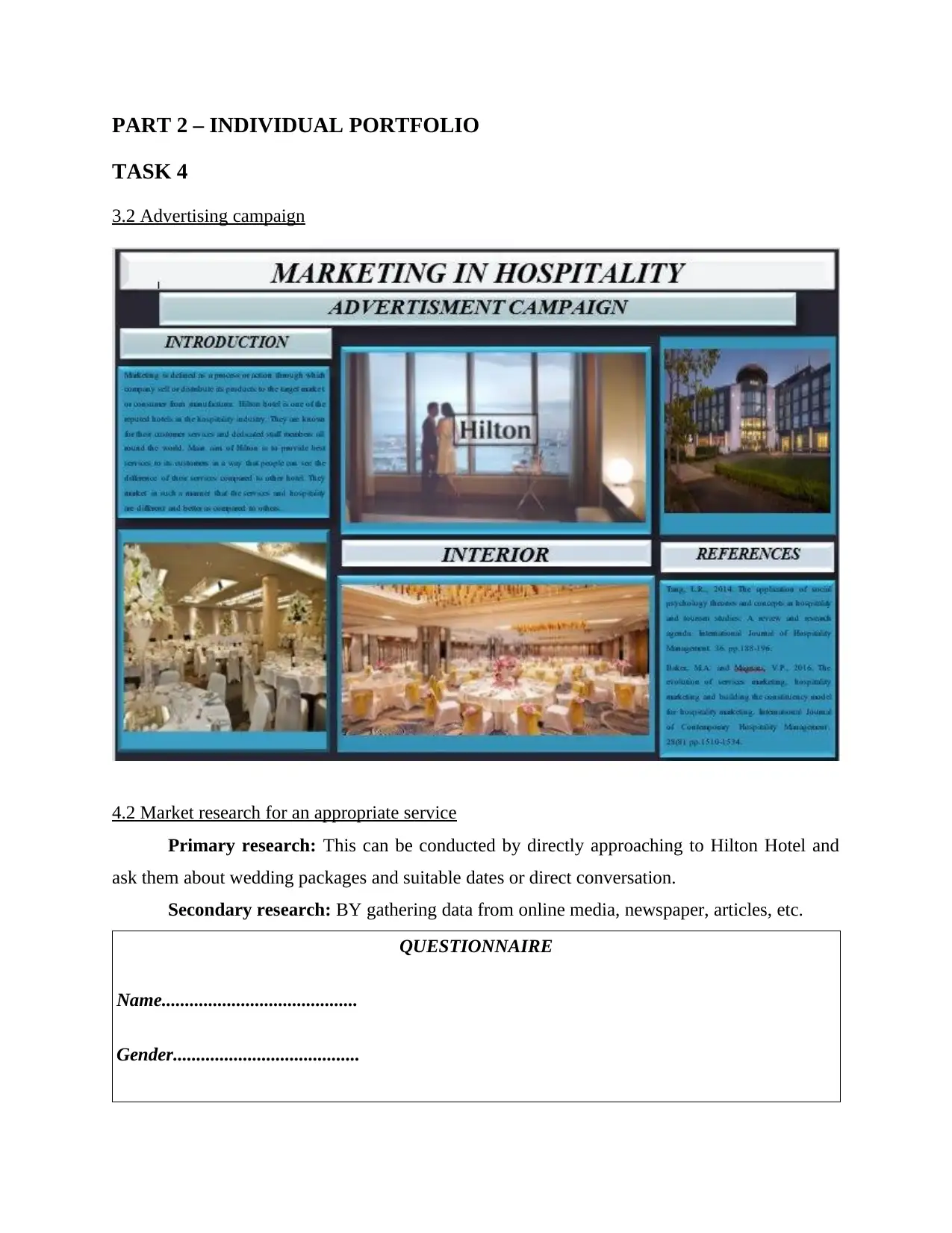
PART 2 – INDIVIDUAL PORTFOLIO
TASK 4
3.2 Advertising campaign
4.2 Market research for an appropriate service
Primary research: This can be conducted by directly approaching to Hilton Hotel and
ask them about wedding packages and suitable dates or direct conversation.
Secondary research: BY gathering data from online media, newspaper, articles, etc.
QUESTIONNAIRE
Name..........................................
Gender........................................
TASK 4
3.2 Advertising campaign
4.2 Market research for an appropriate service
Primary research: This can be conducted by directly approaching to Hilton Hotel and
ask them about wedding packages and suitable dates or direct conversation.
Secondary research: BY gathering data from online media, newspaper, articles, etc.
QUESTIONNAIRE
Name..........................................
Gender........................................
⊘ This is a preview!⊘
Do you want full access?
Subscribe today to unlock all pages.

Trusted by 1+ million students worldwide
1 out of 16
Related Documents
Your All-in-One AI-Powered Toolkit for Academic Success.
+13062052269
info@desklib.com
Available 24*7 on WhatsApp / Email
![[object Object]](/_next/static/media/star-bottom.7253800d.svg)
Unlock your academic potential
Copyright © 2020–2025 A2Z Services. All Rights Reserved. Developed and managed by ZUCOL.





